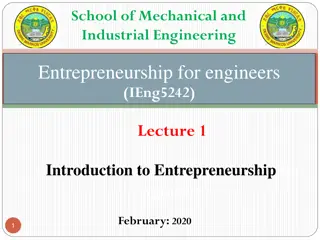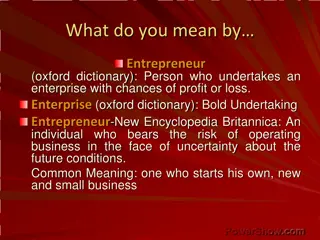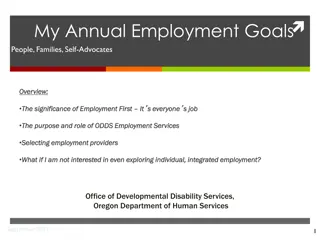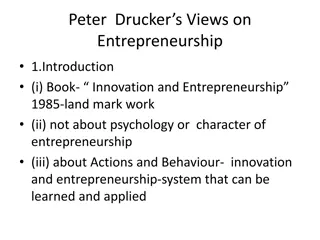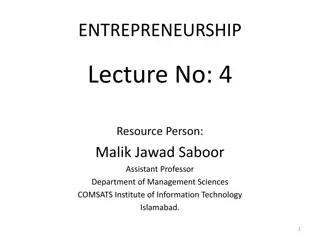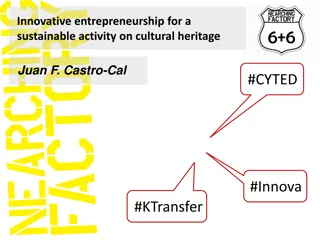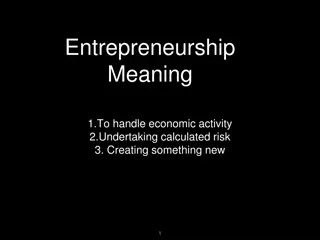Exploring the Dynamics of Employment vs. Entrepreneurship in Business
In the realm of business, the choice between employing individuals or engaging independent contractors can significantly impact operations and costs. This article delves into the considerations surrounding this decision, the advantages and disadvantages of having employees, and the complexities of employment law. From the role of managers to the implications of statutory protections, understanding these dynamics is crucial for business success.
Download Presentation

Please find below an Image/Link to download the presentation.
The content on the website is provided AS IS for your information and personal use only. It may not be sold, licensed, or shared on other websites without obtaining consent from the author. Download presentation by click this link. If you encounter any issues during the download, it is possible that the publisher has removed the file from their server.
E N D
Presentation Transcript
INTRODUCTION Why Employment Law?
THE FOCUS AREAS THE CHOICE BETWEEN EMPLOYMENT AND ENTERPRENEURSHIP RISK POSED TO BUSINESS BY ITS FORMER AND CURRENT EMPLOYEES THE ROLE/AUTHORITY OF THE MANAGER REMUNERATION IN A SPECIALIST INDUSTRY IN RAPIDLY CHANGING TIMES THE NEW LABOUR ACT
THE CHOICE BETWEEN EMPLOYMENT AND ENTERPRENUERSHIP
In engaging persons for provision of labour, there are instances where it may be beneficial to have employees, while independent contractors may be better in others. The decision on which services to engage is dependent on the kind of enterprise you are. Are you driven by flexibility in service provision, or do you prefer exercising some form of control on how your work is done? The difference coupled with your business model and interests determines whether you will prefer to hire independent contractors or have employees.
EMPLOYEE you gain much control over the employee including all things from behavior control like what needs to be done and who directs the tasks etc and in what order to start with. Then there s the fact that an employee is paid a salary and as the employer you need to setup complete employee accounts and withhold taxes and file those taxes along with benefits and the rise in those costs paying employees is a costly business considering it takes time and expertise to accomplish those tasks as well as money.
ADVANTAGES OF HAVING EMPLOYEES You don t need to continually train staff on how you like things done. Your employees know you and can do the work without the need for continual training. You exercise control over how and when work is done. They are always available for any other duties that may arise, while the contractor only works in accordance with duties stipulated in the contract.
Employees have company loyalty and are keen on promoting the company brand. Can establish personal relationships with clients, which may aid in increasing business. DISADVANTAGES OF HAVING AN EMPLOYEE Most full time employees expect benefits provided in statute and CBAs and paid leave, resulting in higher costs than where you contract independent contractors.
Too many statutory protections of employees e.g minimum wage is stipulated, payment of benefits, termination procedures are all regulated and at times difficult to abide by.
CONTRACTOR A contractor does the assigned tasks, issues you an Invoice which you pay, and then that s it there are no employer tasks like taxes or benefits or training costs. There are no worries about overtime or minimum hourly wages or vacation time or sick time or retirement or pension costs .nada. You pay only what the Invoice says is owing and if you properly negotiated that amount up front you know your costs going into a deal with a contractor.
Advantages of an independent contractor An employment relationship is subject to statutory control and restrictions (dismissal, terminations, leave, hours of work, termination of contract). All this protection is premised on the fact that an employee is considered to be the weaker party in the relationship. Such statutory protections and limitations are however not present where you contracts an independent contractor. The only regulator in terms of the law is the contract itself and the law of contract in general.
An employer has greater flexibility. When you work with an independent contractor and it isn t a good match, you simply don t hire them again. When you have an employee that doesn t work out, you may need to fire them but you have to follow the legal procedures for termination as provided in the Labour Act. Although you usually pay more per job or per hour, you will most likely save money overall since you aren t required to pay any benefits and there is no need for paid leave.
Disadvantages of independent contractors You lose some control over how tasks are performed, because you can t closely monitor their work. You can guide them, but usually they will do the work their way. This generally tends to affect the uniformity in company presentation which comes with having employees who do their work and present themselves in a similar manner. They are hired short term, so you might not get the same worker for the next project. May therefore result in company constantly changing persons who will deal with its clients, yet in some instances clients want to have a personal relationship with persons who handle their business.
They have no sense of company loyalty, but are a hired gun for one specific job. They are not part of your staff. May therefore not promote your brand in a manner employees of a company would.
CONSIDERATIONS Whether to have full time employees or hire independent contractors is dependent on the following; Length of Project If this is for an ongoing project requiring continual work with no definitive end date then you may need to hire an employee unless this work requires high skills, knowledge and no direction from you. Client contact Should the work that needs to be done require constant or very periodic client contact you can t do better than haveing an employee on staff to represent you and your own brand and ensure that there is continuity in proscribed methods and communications etc. etc.
Remote work Does the task list include what can be done remotely and if so then a contractor is the way to go for sure freeing up valuable company funds that will not be spent on offices and utilities and other operational costs. Damage control If you ve ever had to fire employees for cause or for business turndowns or in fact for any reason you know how painful that can be for both your employee and you .but when it comes to contractors you simply need to turn off the work tap and they then await the next time you offer up projects to them.
RISK POSED TO A BUSINESS BY ITS FORMER AND CURRENT EMPLOYEES
Scenario: One of your companys longest-serving and most senior employees resigned recently. His departure was cordial. A farewell lunch was held and was enjoyed by all. A few weeks later, you stop hearing from several of your company s most valuable customers. It soon becomes apparent that your former trusted colleague contrary to what he had told you during his exit interview has established a new business in the same field, which is directly competing with your company. A meeting is convened to determine your company s strategy. To the dismay of your company s new chief executive officer, it is revealed that the former employee had insisted for many years that detailed records of all transactions with customers be prepared for him and updated on a weekly basis. And nobody could tell why until now.
Armed with this information, your former trusted colleague sets about poaching more of your company s valuable customers, offering discounts on current prices , and demonstrating an uncanny knowledge of each customer s previous purchasing preferences and product lines. The business is no longer viable. Your former trusted colleague feels a level of guilt, as he switches from fifth to sixth gear in his new Jaguar XL.
The risks posed to businesses by their former and current employees have never been greater. But what steps can you take to minimize the risks of nightmarish scenario such as is described above destroying the profitability of the business? You can use restraint of trade clauses to protect its interests. A restraint of trade clause is a contractual provision restraining your employee from employment or trade post his employment with you.
You can use restraint of trade clauses to protect its interests. A restraint of trade clause is a contractual provision restraining your employee from employment or trade post his employment with you. Restraint of trade is not for every employee but for those employees that could threaten the business if they left to join or becomeyourcompetition. A restraint clause will only be enforceable if it protects a legitimate business interest, otherwise it will be regarded as an unlawful restraint of trade. The only recognised business interests are: I. trade connections (including between the business scustomersand its workforce) II. trade secrets and confidential information. the relationship
The clause must identify; (a) The typeof work to which the restraint applies. it to what he was doing (scope, geography)- may limit do you tell. Limit to Limit and duration but difficult- how customers projects orcompetition. (b) The geographical area i.ewhere your clients are. (c) allow the The restriction should be fora limited employee s time i.e to influence toend.
Whether a restraint of trade clause is warranted and its extent is something our courts may determine and underwrite for the parties in the event of a dispute. The court is allowed such powers since such clauses can take away an employee s source of livelihood if left unchecked. The court will balance between your need for protection and the employee s need to earn a living from his education, skills and experience.
Non compete clause Non compete clauses prevent an employee (or former employee) from competing with you. A clause of this type which applies during the period of employment will be valid where it is reasonably necessary and adapted to protect the employer s business interests.
Non solicitation/Non Dealing clause This form limits the employee from doing business with your clients, either as an employee of a competing firm or a service provider in his own right (businessman). It includes non dealing clauses and non- solicitation clauses.
Non-dealing clause It prevents the employee from dealing with clients or suppliers of their previous employer regardless of who initiates contact. It covers not only enticement or interference (where active steps are taken by the former employee), but also the provision of services where no active steps are required (for example, where the customer approaches the former employee).
This type of clause has a clear advantage as it avoids the need to prove that the former employee made an approach, which is usually difficult to show. However, it does broaden the prohibition and consequently may make it more difficult to enforce.
NON SOLICITATION Non-solicitation clauses prohibit a former employee from seeking out and trying to take (or solicit ) the your clients. In determining whether solicitation has occurred, who makes the initial contact is not decisive. It may still be solicitation where the client makes the first contact and a former employee, in response to an approach by a client, goes beyond merely showing a willingness to be engaged and positively encourages the client to engage him or her.
Non poaching clause A non poaching clause prevents a former employee from poaching your existing employees (his former colleagues). It is an enforceable restraint as the stability of the business s workforce is a legitimate business interest. It should be limited to those employees at the same level as the former employee and those more senior to them. Any clause that attempts to prohibit the poaching of employees will need to consider: How long the former employee s influence over the other employees will last. The roles of the employees over whom the influence exists.
NON DISCLOSURE CLAUSE A confidentiality clause is the contract that asks the employee to refrain from disclosing certain confidential information. This applies to employees who are likely to be privy to the company s confidential information. Where confidential information is disclosed, and you do not have written confidentiality clauses in the contract of employment, you will be at the mercy of a judge s subjective interpretation of the contract and the common law rules, as to whether information disclosed by the employee was confidential.
The existence of a confidentiality clause in the contract of employment on its own does not afford you sufficient protection. The wording of the clause is of utmost importance. Confidentiality clauses must define what is and is not confidential information, so that employees (and if necessary, judges) know what information you, as the employer are (and are not) seeking to protect. A confidentiality clause can be worded in one of the following ways;
General Description: General descriptions will usually read as follows: I agree not to use or disclose any trade secrets or confidential or proprietary information of ABC Company . The advantages to this type of description are that they are easy to write and may give the broadest coverage, because almost anything that could fall within that description is potentially covered including future or unanticipated items. On the down-side however, it is so vague that it really does not define confidential information , which can result in disputes as to exactly what is covered by the agreement.
II. Specific Description: This type of description will specifically spell out either in the body of the contract or in an addendum attached to the contract what information will be defined as confidential . Typically, a specific description will include (without limitation) client lists, pricing information, trade secrets, formulae, market research documents and the like. E.g
Confidential Information means any information, data, or materials (whether or not recorded) of a proprietary or confidential nature, whether in oral, written, graphic, machine readable form, or in any form ( Confidential Materials ) relating to parties and their affiliates , their past, present and future products or services, including but not limited to: any Confidential Materials which a party or its affiliates treats or marks as confidential or in respect of which it owes an obligation of confidentiality to any third person; any trade secrets, secret formulae, processes, techniques, intellectual property, documentation, files, graphics, surveys, plans, drawings, presentations, reports, charts, lists, and tables, conversations or expressions, samples, models or prototypes, or parts thereof when appropriate; information or data of a business, company, clients, including but not limited to corporate, financial , technical, scientific, legal, operational, proprietary, developmental, marketing, sales, price, operating, performance, cost, know- how, and/or process information; information about the business owners, directors, officers, key personnel, employees, consultants, agents and representatives, computer programming techniques, and all record bearing media containing or disclosing such information and techniques; any or all which is disclosed whether in writing, orally or by any other means by one party (Disclosing Party) or by a third party acting on behalf of the Disclosing Party, to the other party (Recipient) whether before or after the agreement.
III. Marked Items: Confidentiality clauses can limit nondisclosure to items marked approach eliminates doubts about what is covered, but it does not protect information not reflected in written documents, and employees may forget to mark materials items that are so marked, strong likelihood of enforceability. confidential . This confidential . For however, there is a those
IV. The best approach is to take the middle ground encompassing all these methods. This blends all the advantages of the other three. Typically, a definition using this approach will read as follows: As used in this Agreement, Confidential Information means a) information identified in Exhibit A of this Agreement, attached hereto; b) information marked by the Company as confidential, c) information treated by the Company as confidential.
The clause should also provide for the penalty where a current employee breaches the confidentiality agreement. Confidentiality clauses generally remain in force whilst the information protected remains confidential. This means that the clause may apply during employment and potentially long after the employment ends.
THE ROLE/AUTHORITY OF THE MANAGER The constitution and fair labourstandards S65 (1) of the constitution every person has the right to fair and safe labour practices and standards and to be paid a fair and reasonable wage. The Labour Act recognizes in s2 the promotion of fair labour standards. Both statutes do not provide a definition of fair labour standards. Though fair and labour standards are not defined in constitution, the concept of a fair labour practice recognizes the rightful place of equity and fairness in the workplace. (National Entitled Workers Union v Commission for Conciliation, mediation and Arbitration and Others [2003] ZALC 173) Equity and fairness includes democracy in the workplace.
Democracy and Participation By Employees In Decisions Affecting Them
S2 of the LabourAct which establishes democracy in the workplace provides, S2A (e) the promotion of the participation by employees in decisions affecting their interests in the work place Managers are no longer answerable to the Board only but also to the employees. Management is now under an obligation to involve employees in decision making, on decisions that affect the interests of employees. e.g retrenchment, withdrawal of benefits, transfer etc. Democracy is exercised through consultations with the employees regarding matters that may affect them. Where individual decisions such as transfer of an employee are contemplated, the employee concerned should be concerned before the final decision is made. Where it involves a larger number of employees or all employees such as the withdrawal of a benefit for the employees, or retrenchment consultations still have to be done.
Consultation involves informing the employees concerned of the decision to be made and giving them the opportunity to make representations giving their views. Such representations and views ought to be considered by management in making a decision. Making a decision contrary to the employee s views is allowed, what is important is the consultation.
REMUNERATION IN A SPECIALIST INDUSTRY IN RAPIDLY CHANGING TIMES
The remuneration of any employee has to take into account the possible change in fortunes of the company. Any benefits should therefore be considerate of the fortunes of the company. A contract should therefore i. Ensure that contracts are made as flexible as possible. ii. Include clauses which do not make benefits payable despite the fortunes of the company. The contract should, when interpreted, always consider the performance of the company in payment of benefits. Contractual And Discretionary Benefits Discretionary benefits are those benefits that are not mandated by law. Such benefits might include medical insurance for the employee and her family, a pension plan, tuition assistance. The employee chooses whether or not to pay these benefits, and how they are paid.
Conditional Benefits Conditional payments are payments which are hinged on the fulfillment of certain requirements. Conditional are benefits payable subject to fulfillment of certain conditions stipulated in the contract of employment. Unless the conditions are fulfilled, payment of the benefit does not become due. Examples of conditions are i. Availability of funds ii. The employee s individual performance iii. Company performance
Such conditions are provided for in the contract of employment. For example, ...the employee will be allocated a new vehicle of his choice every five years subject to availability of funds. The condition is subject to availability of funds. Before the benefit can be paid, the condition has to be fulfilled, that is there should be availability of funds. Where the benefit is dependent on company performance and the individual s performance, you can avoid payment of some benefits where you cannot afford it. It is easily justifiable that there are no funds to allow for the payment of benefits. Salary Differentials Employees may be in the same grade but will be differentiated on the basis of several things. You may choose to differentiate the salaries of insurance practirioners from other employees in the same grade as them on the basis that they are the cash cow. The fact that an employer pays an employee more than other employees does not per se amount to discrimination pay differentials may be justified in law and in practice by the fact that employees have different levels of qualifications, experience, skills, competence, expertise and so on. It will only be regarded as discrimination when two similarly cirumstanced employees are treated differently.
THE NEW LABOUR ACT
FIXED TERM CONTRACTS A fixed term contract is a contract that specifies the duration of the contract, and states the exact date of termination. In terms of s12(3a) of the labourAct a fixed term contract shall be deemed to be a contract of employment without limitation of time upon the expiry of such period of continuous service as is-
(a) fixed by the appropriate employment council; or (b) prescribed by the Minister, if there is no employment council for the undertaking concerned, or where the employment council fixes no such period; Once deemed to be a contract without limit of time, the employee concerned shall be afforded the same benefits as employees who engaged without limit of time in terms of the labour Act and any CBA. A fixed term employee can have his contract of employment terminated on notice in terms of s12 (4a), but without any compensation being due.
TERMINATION ON NOTICE The amendment inserted a new provision s12(4a) which addresses termination of a contract of employment on notice. Section 12 (4) of the LabourAct provided for the common law right of an employer to terminate a contract on notice to an employee. It provided the respective notice periods for various durations of contracts of employment. s12 (4a) limits the exercise of that right by providing when termination on notice can occur.
In terms of the provision termination on notice can occur; If the termination is in terms of an employment code or in the absence of a code in terms of the model code (Labour (National Employment Code of Conduct) Regulations,2006). II. By mutual agreement in writing between the employer and the employee to terminate the contract III. Where the employee was engaged for a fixed period or forthe performance of specific services IV. Pursuant to retrenchment An employer can only terminate a contract on notice for the reasons or in scenarios cited above. I.
COMPENSATION FOR TERMINATION ON NOTICE Section 12 (4b) provides for compensation for employees whose contracts are terminated on notice. Where an employee under a contract without limit of time is given notice of termination of contract in terms of s12 (4a), such employee will be compensated in accordance with the compensation procedures under s12C. The compensation package as provided in s12C (2) will be a minimum package of not less than one month s salary or wages for every two years of service. In terms of section 12C (2) an employer can also apply for exemptions from paying the minimum compensation package.


